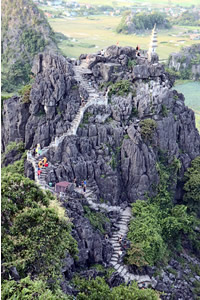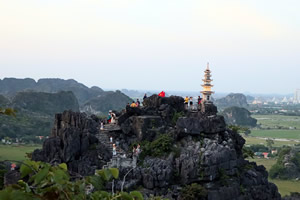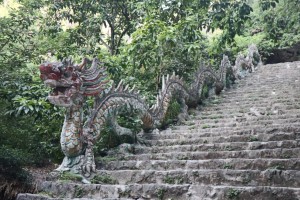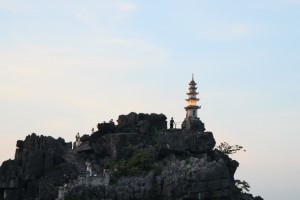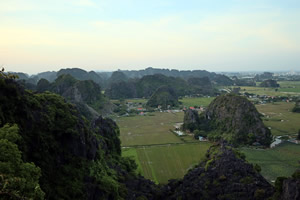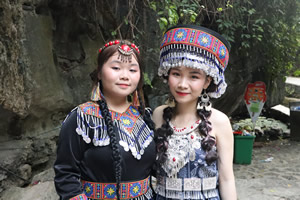Hang Múa and its famous twin pinnacles is one of the top attractions in Ninh Binh province. Climbing approximately 500 stone steps carved into the rock to reach the summit is both a tiring and rewarding experience. Early Mornings and late afternoon are the recommended times – both for the panoramic sunset/sunrise views and for your general health. It can get very hot at midday on the mountain!
To this end, the entrance area is well shaded with lots of small coffee shops, restaurants and even homestays if you really want to get an early start! Either way, Hang Mua is a truly special and unforgettable experience with stunning panoramic views of the countryside everywhere as well as many convenient “selfie” spots to update your SM accounts with!
The Hang Múa geographical environment is not much different to the ancient weathered limestone karst mountains and valleys that typify much of northern Ninh Binh. What sets it apart is it’s height, history, architectural brilliance and spiritual significance. Plus of course, the provided 500 plus “stairway to heaven” which gives access to these antiquities and relatively easy access to the breathtaking views from the top of one of the geological giants that typify the area.
Early History
Located in Khe Dau Ha village in Hoa Lu district, Múa Cave is approximately 10 km southwest of Ninh Binh city. The Hang Múa observation deck on the left hand fork of the stairs is 142m high and 800m wide, renovated and opened for tourism in 2000. However, the natural vantage point for surveying the surrounding countryside dates back to as early as 1226, when it became a strategic asset for tracking and eventually repelling the Mongol invaders of the Yuan (China) dynasty.
After the old capital of Hoa Lu moved to Hanoi, people still held Ninh Binh and Hoa Lu in high regard and used them as a retreat from the affairs of state. They also used Múa Cave and the high pinnacle of Múa Mountain for meditation retreats and the more worldly charms of festivals and feasts.
The first Tran Emperor, King Tran Thai Tong (1218-1277) initiated such activities when he returned to Hoa Lu to construct the nearby Thai Vi temple. He and his concubines often visited Hang Múa to dance and sing atop what they considered the roof of the world.
Skipping forward through the centuries, during the various resistance wars against the French and American invasions Hang Múa also served as a triage hospital for the treatment and shelter of wounded soldiers..
Architecture
The spires at the peak of the mountain are similar in architecture to the local pagodas, with pointed tops and tiled arched roofs. A delicate dragon image at the foot of the stairs welcomes travelers on their journey upwards. About two thirds the way up. you come to a fork in the road.
Turning left is the higher of the two pinnacles, with a wide viewing platform and at the top of yet another flight of stairs, a long snaking dragon that overlooks and protects the large white marble statue of Guanyin (Quan Am in Vietnam) facing the wilder south west tumble of mountains and lakes. Many consider this Buddhist duo to be welcoming the sunrise and sunset from their lofty perch, and the dragon is known as the “tallest” in Ninh Binh.
Various images of animals, such as the Nghe (Vietnamese guardian lions) statues plus reliefs depicting the spiritual and architectural culture of the Vietnamese people can be found on either side of the stairway. These figures, placed on stone pillars, create a sense of companionship and protection during the arduous climb.
Turning right will take you to the pagoda area and the small Buddhist tower that overlooks the farms and villages hundreds of meters below.
The tower is built in the Buddhist stupa style found throughout Asia, featuring a square base symbolizing the land, a round gourd-like section representing water, a pointed cone pointing upward representing fire, and a canopy representing the wind. The uppermost section symbolizes “Khong Dai,” an abstract concept of being both spirit and matter, or all and nothing.
The Spirit of Hang Mau
These five elements relate to the five human senses: touch, taste, smell, sound, and form. The symbolism of the pagoda intends to make people ponder the world, their place in it, and rise above materialism into wisdom.
A long, large dragon at the top represents Nghe, one of the 9 children of God. This motif is typical in Vietnamese religious architecture and, like many other Asian countries, heavily influenced by Chinese culture. The bird statue atop the columns on the path represents eagles dancing, a symbol of great power. At the very top of Múa Mountain, at the end of the path, stands a stark white statue of Bodhisattva Avalokitesvara, the compassionate one, known locally as Guanyin.
According to ancient myths, the Vietnamese people (Viet Kinh) originated from the union of a dragon and a goddess/fairy. As such, dragons play an iconic role in Vietnamese architecture. Like most Southeast Asian countries, Buddhism has been a strong and preserving influence in traditional Vietnamese culture but local myths run strong. There is some debate over whether the dragon at Múa is worshiping the Bodhisattva or the other way around!
Travel Tips
Hang Múa’s foothills have sprouted many hotels, restaurants, and tour companies as it a popular destination in Ninh Binh that can get very crowded on weekends and public holidays. To avoid the crowds, visit in the early morning before the sun gets too high and tour groups arrive.
The Tam Coc Harvest season, between May and June, is the optimal time to visit when the weather is sunny yet cooler, making it ideal for outdoor activities. Visits are best in the early morning, as the sun can become oppressive after 11:30 am, especially for those not used to the tropical climate.
After completing the climb, relax by the beautiful lotus pond at the foot of the mountain or visit Hang Múa cave. There are also a number of eateries, cafes and kiosk to suit most needs and, as mentioned, several homestays if you really want to spend some serious time here.
You can avoid the crowds in autumn and winter, provided that the rain stays away. Alternatively, spring is a season of local festivals, offering an opportunity to immerse yourself in the local culture and customs.
Logistics
To get to Hang Múa, you can easily ride a motorbike, which is often more affordable than taking a taxi or hiring a car. Your hotel in Tam Coc or Trang An can also help you arrange either transportation. You will need to pay an entry fee of 100k vnd to enter the Hang Múa Complex and expect to spend another 10k if parking a motorbike.
The Lotus Pond, the “Hang” (cave) and the majority of the cafes are inside the barrier, whether you want to do the climb or not. You can also buy Non la (palm-leaf conical hats) from locals for about 30,000-50,000 VND each or rent traditional costumes for unforgettable photos.

